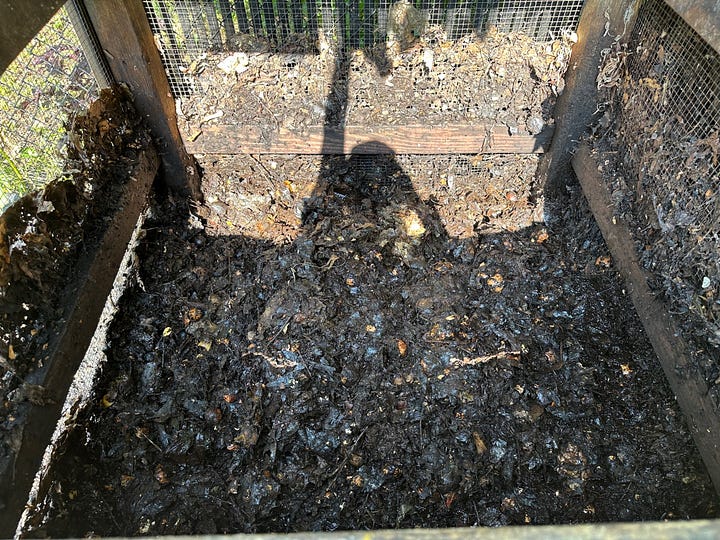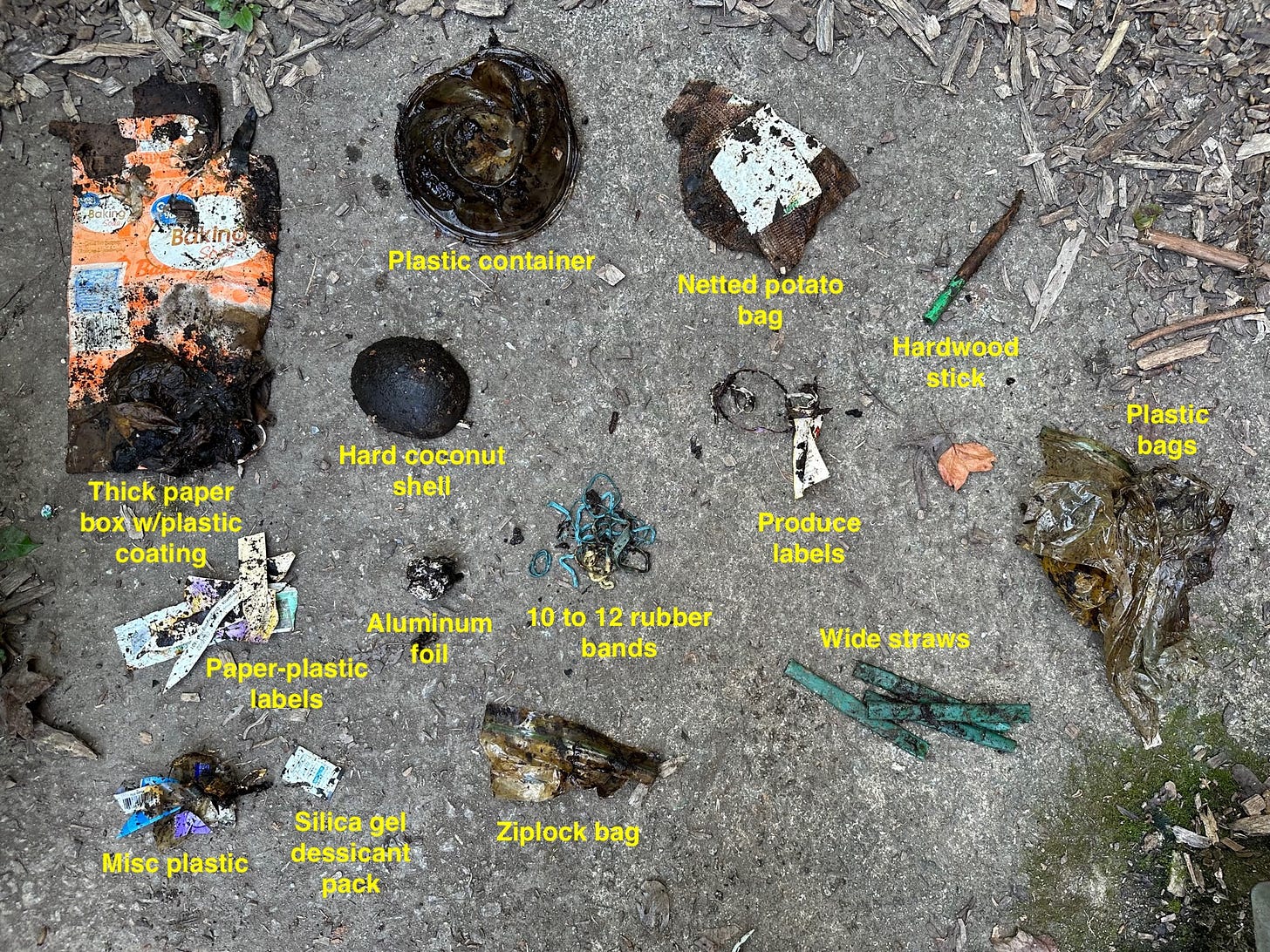Soundtrack: Album: Wasteland, Baby! by Hozier
Hello! Welcome back. This week’s post is slightly delayed because as promised, it’s gotten philosophical. I’ve not only been learning from the pile but from books, packaging companies, and compost companies that I’ll detail further.
But before we go on, I’d like to address the “soundtrack” that I specify at the beginning of the post and changes week by week. The soundtrack is what I listen to as I turn the compost; usually an album, podcast, or interview that’s about an hour long, and totally not required to read or understand this post or composting at all. Just a documentation for me to remember what the vibe was like that week. :)
This week’s soundtrack was Hozier, which was borderline gospel and surprisingly appropriate for a bin 1 turn. Like I said.. it got philosophical.
The Turn


It took about 4 hours to fill up bin 2, yet bin 1 still has about 15-20% of material at the bottom. I feel two ways about this result: 1) fantastic, because it shows that the pile’s volume is increasing and its density is decreasing, 2) worried, because without a strategy for the remaining bin 1 materials, it’ll stay trapped at the bottom of the bin for all time to come.
Going deeper on feeling fantastic— the decrease in density shows that aerobic (with oxygen) conditions are being created for decomposition to occur. In previous weeks I’ve talked about the importance of airflow for the removal of moisture, survival of good bacteria, and overall breakdown processing, but it has a significant importance in the bin 1 to bin 2 transition. Let’s consider the scenario where bin 1 is never turned and left as a static pile of food scraps that continues to build. In this environment, materials in the bottom 50% of the pile are so weighed down by the materials above that they are water-logged and saturated in their own moisture such that it creates anaerobic (without oxygen) conditions. Then, a process called putrefaction releases acidic and sufurous compounds from the materials as they breakdown (aka rank smells all around). The tendency toward anaerobic conditions is highest in bin 1 because of the high moisture content in materials before they’ve been turned. And bless their heart, the leaves that get added on top of the food scraps are great for carbon but not great for soaking up moisture. Moral of the story, unless you’re aiming for anaerobic composting, make sure there’s some air in there!
That said, I added sawdust between layers of bin 2 to soak up extra moisture and vigorously scraped the remaining materials in bin 1 so that they still got a little breeze. However, I’m formulating a plan so that next time a bin 1 turn comes around, I’ll be able to empty the bin entirely.
Keepin’ on Cookin’
The last month and a half, I’ve been reading Cooked by Michael Pollan where he describes cooking through the 4 elements: Fire, Water, Air, and Earth. While I enjoyed the whole book, the section on Earth stood out because it focused on what The Compost Bean is all about— watching Earth doing its thing and asking what we can do to help. Pollan focused in on how we can use Earth to cook through fermentation, beautifully noting:
Fermentation, like all the other transformations we call cooking, is a way of inflecting nature, of bringing forth from it, above and beyond our sustenance, some precious increment of meaning.
It’s hard to separate the Compost Transformation (CT) from this description of fermentation, albeit my small rant from before about the importance of aerobic conditions particularly to prevent fermentation. The CT is never clearer or more humbling to me than a bin 1 turn because as I get lost in scooping what looks like a smelly sludge filled with maggots, people come up with their little containers of fresh food scraps to donate. Once you get past the reflexive disgust of rotting food scraps, it’s kind of glorious to witness Earth doing her thing and bring the nutrients full circle. Speaking of, I found a company in NYC called Groundcycle that has a Bin Swap program providing fresh produce in exchange for food scraps. I’m sure that part of the program’s success is because it allows CT to become intertwined in their customers’ daily lives and be mindful of its importance.
Treasure Time
No surprises as such, although I had more empathy for our donors this week. There’s something very modern about getting our trash out of our house as soon as possible. Going back to the reflexive disgust of rotting food scraps, the same can be said for things that have been “used already.” There’s a rush that comes from getting it out of our sight and making room for more. New things to buy, how fun! With that rush, there are some trinkets that get lost in the mix. And hey, I’m happy that our donors are diverting their food scraps from the landfill at all.
On the other hand, I found a couple of these Fresh Harvest bags that say they’re “Home Compostable” so I can assume that the donors tossed them in on purpose (please empty out the bags first if you do this!). They didn’t seem to have broken down at all, so I looked into the manufacturer of the packaging and found TIPA. They make bio-plastic packaging that is home and industrial composting-friendly and should break down completely in 6 months. Even so, I found no signs of weardown (assuming these bags had been in the bin at least 4 weeks), which I found strange and sent an inquiry to the company to learn more the ideal breakdown environment. Next time I see them, I’ll be sure to leave it in the bin to experiment!
That’s all for this week! We’ll be back at bin 6 next week, which will be a nice reprieve. Also, if you’re interested, check out the project tracker here.





